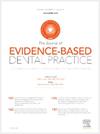THE ROLE OF OZONE THERAPY IN THE TREATMENT OF TEMPOROMANDIBULAR DISORDERS: A SYSTEMATIC REVIEW
IF 4
4区 医学
Q1 DENTISTRY, ORAL SURGERY & MEDICINE
引用次数: 0
Abstract
Background
Temporomandibular disorders (TMD) refer to a range of conditions affecting the temporomandibular joints (TMJ), masticatory muscles, and related structures, bothering around 12% of the population. This systematic review aims to answer whether ozone therapy effectively reduces TMD-related symptoms.
Methods
A systematic electronic search of 6 databases was conducted on July 15th, 2021, and updated on November 17th, 2023. Only clinical trials published in Portuguese, English, or Spanish were selected, with no restriction to the year of publication. Animal studies, retrospective studies, case reports, review papers, meta-analysis, and ozone therapy applications outside the orofacial region were excluded. The risk of bias analysis was performed following the Cochrane Collaboration tool, RoB 2.
Results
Of the 315 articles identified in the search, only 7 studies were included in this review. Two studies were considered low risk of bias, 2 with some concerns, and 3 as high risk of bias. Ozone therapy, applied to both articular and muscular TMDs, has been shown to reduce pain intensity and palpatory pain, and improve pressure pain thresholds and mandibular range of motion.
Conclusion
Ozone therapy emerges as a potential therapy for reducing TMD-related symptoms. However, the current evidence lacks robustness, and further high-quality randomized controlled trials are necessary to enhance the existing evidence base.
臭氧疗法在治疗颞下颌紊乱中的作用:一项系统综述
背景:颞下颌关节疾病(temporomandibular disorders, TMD)是指影响颞下颌关节(TMJ)、咀嚼肌和相关结构的一系列疾病,困扰着约12%的人口。本系统综述旨在回答臭氧治疗是否有效减轻tmd相关症状。方法于2021年7月15日对6个数据库进行系统电子检索,并于2023年11月17日更新。仅选择以葡萄牙语、英语或西班牙语发表的临床试验,不受发表年份的限制。动物研究、回顾性研究、病例报告、综述论文、荟萃分析和臭氧治疗在口腔面部以外的应用被排除在外。采用Cochrane协作工具RoB 2进行偏倚风险分析。在检索到的315篇文章中,只有7篇研究被纳入本综述。2项研究被认为是低偏倚风险,2项研究有一些关注,3项研究被认为是高偏倚风险。臭氧疗法,应用于关节和肌肉TMDs,已被证明可以减轻疼痛强度和触诊疼痛,并改善压力痛阈值和下颌活动范围。结论臭氧治疗是减轻tmd相关症状的潜在治疗方法。然而,目前的证据缺乏稳健性,需要进一步的高质量随机对照试验来增强现有的证据基础。
本文章由计算机程序翻译,如有差异,请以英文原文为准。
求助全文
约1分钟内获得全文
求助全文
来源期刊

Journal of Evidence-Based Dental Practice
DENTISTRY, ORAL SURGERY & MEDICINE-
CiteScore
6.00
自引率
16.70%
发文量
105
审稿时长
28 days
期刊介绍:
The Journal of Evidence-Based Dental Practice presents timely original articles, as well as reviews of articles on the results and outcomes of clinical procedures and treatment. The Journal advocates the use or rejection of a procedure based on solid, clinical evidence found in literature. The Journal''s dynamic operating principles are explicitness in process and objectives, publication of the highest-quality reviews and original articles, and an emphasis on objectivity.
 求助内容:
求助内容: 应助结果提醒方式:
应助结果提醒方式:


